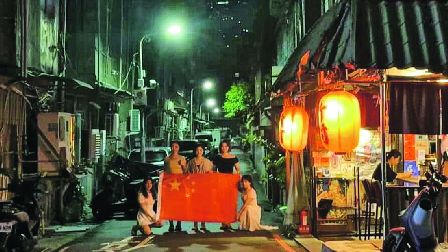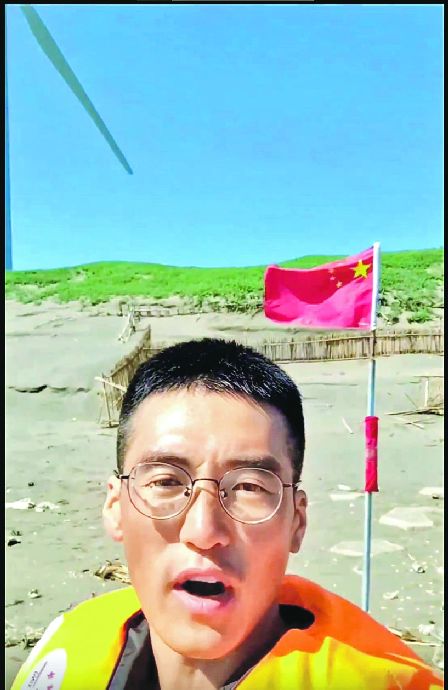<轉載自2025年5月19日 明報 社評>
台灣行政院網站近日因被揭發把佔全台人口逾96%的漢人稱為「其餘人口」,引起軒然大波,批評者直指民進黨當局推動「文化台獨」。綠營辯稱相關調整旨在促進族群平權,但其邏輯無法服眾,難脫瓜田李下之嫌。事實上,自去年5月20日上台以來,賴清德「去中國化」舉措屢見不鮮,與其過往「務實台獨工作者」的自我定位相互呼應。明日就是賴清德掌權一周年,他上任前曾宣示要推動「國家重建、社會改造、洗滌人心」,這一年裏他不斷踩着綱線衝擊兩岸關係的和平根基,把台灣置於更加危險的境地。
賴清德踩鋼線「謀獨」 國台辦斥荒謬絕倫
網站資料顯示,行政院在今年3月24日已更新「族群」介紹,指台灣「目前已設戶籍人口2.6%為原住民族群,另外來人口佔1.2%,其餘人口佔96.2%」。台灣總人口2336.5萬,族群介紹詳細區分少數族裔包括16個原住民族與蒙藏族,又根據使用語言劃分出原住民、客家、蒙藏、新住民與移工等,卻隻字不提2200多萬的「其餘人口」如何組成,也不說他們的母語要麼是國語(普通話),要麼是台語(閩南話)。如此欲蓋彌彰,活脫是現代版此地無銀三百両。
行政院辯稱,台灣只有原住民族群須依法登記,其他族群無法分類統計,全數歸為漢人又與事實不盡相符。眾所周知,絕大多數台灣人為大陸移民後裔,而漢是全球共認的中國主體民族,所謂與事實不符,只是掩人耳目的說辭。顯而易見,「漢」之所以敏感,恰恰因為它無時無刻不在突顯兩岸的文化、歷史與血脈連結,觸及綠營的政治忌諱。綠營無法憑空揑造一個「台灣族」,就只能掩耳盜鈴,把祖籍福建漳州的賴清德,以及一眾家譜背景相似的民進黨人都劃為「其餘人口」。國台辦斥責其荒謬絕倫,「不知有何顏面面對列祖列宗」,可謂一針見血。
從全球慣例來看,多數地區採用族群分類統計,但也有國家反其道而行,法國就為了體現「自由、平等、博愛」立國精神,完全不把族裔納作統計元素。人口統計與公共資源分配、社會政策制訂密切相關,這兩種統計方式孰優孰劣難有定論,但像綠營當局那樣以促進平權為名突出極小比例人口,卻同時抹掉大多數人口的族裔背景,實在有違常理。兩岸同文同種、同根同源是不爭的事實,「一中原則」也是眾多國家與國際組織遵循的準則,面對綠營日益猖獗的「台獨」操作,北京軟硬兼施的力度不斷加強。綠營在國際博弈中上不了台面,也無法直接抹掉台灣的中華文化屬性,於是轉求人為扭曲,企圖改變社會認知。這也許才是不惜把自己也變成「其餘人口」的真正目的。
有國民黨立委直斥,把台灣民眾盡皆劃歸「其餘人口」,證明民進黨「去中國化」走火入魔。「獨派」陣營也有人提出質疑。專研少數族裔議題的東華大學原住民民族學院前院長施正鋒便指出,一般國家介紹族群結構由多到寡,剩餘者通稱「其他」,當下民進黨政府卻以平權為藉口,試圖遮掩台灣現有人口都是先後由大陸遷徙而來的事實。他詰問:「綠營人士津津樂道混有日本,甚至荷蘭的成分,竟然自我否定為殘餘的『其他』?」類似質疑最近一年內多次出現在輿論場,矛頭直指賴清德就職演說中把1624年,即荷蘭人征服台南之年,說成是「台灣全球化的開端」,以及發表感念日本殖民統治等言論。
上台一年頻密「抗中」 兩岸關係沉入谷底
賴清德曾以「務實的台獨工作者」自居,掌權以來,他不再把「台獨」高調宣之於口,但「謀獨」動作與同屬民進黨的陳水扁、蔡英文相比,變本加厲。他在上台前曾宣示要做「國家重建、社會改造、洗滌人心」三件事,若用其行為來解讀,所謂「國家重建」,即透過「去中國化」手段重新定義台灣的社會認同,建構一個與大陸切割的實體;「社會改造」是透過修改課綱等方式,改變台灣社會的歷史與文化認知,使其更趨近「台獨」理念;「洗滌人心」則是在意識形態層面強化台灣「民主」對抗大陸「專制」的論述,用各種手段「抹紅」政治對手,把民進黨塑造為台灣選舉政治的唯一正確選擇。
最近數月,民進黨當局在兩岸關係上的民粹操作歇斯底里。除了試圖將台灣人血液中的漢族成分「稀釋」,綠營提出編撰「識讀中國威脅」教材、反對甚至禁止大中小學學生與對岸交流。在內政上,以鼓吹「武統」為由驅逐多名大陸配偶、把對岸列為「境外敵對勢力」,以及把針對國民黨立委的大罷免與「抗中」掛鈎。在國際層面,賴清德月初破天荒舉辦「歐戰勝利日」紀念活動,把原本因應特朗普推行「對等關稅」而拋出的「脫中入北」主張,提升至在歷史認同上迎合西方的層次。
對這些鬼蜮動作,當然不能掉以輕心。任何一方若不斷灌輸對立與敵意,必然破壞兩岸和平統一的根基。另一個危險的警號是,賴清德一系列「去中國化」操作背後有現實政治鬥爭盤算。民進黨目前正無所不用其極推動大罷免,意圖扭轉朝小野大的被動局面。在權力不足時,賴清德尚且不斷玩火,一旦真正全面控制行政與立法機構,難保不會做出更瘋狂的行徑,把兩岸推向萬劫不復的攤牌境地。
"Han" Label
Erased in Taiwan's De-Sinicisation Move
TAIWAN'S EXECUTIVE YUAN
recently sparked controversy after its website was revealed to have categorised
the Han-Chinese, who make up over 96% of the island's population, as
"other population". Critics have accused the ruling Democratic
Progressive Party (DPP) of promoting "cultural Taiwan independence".
Information on the
website shows that the Executive Yuan revised its description of the island's
ethnic groups on 24 March this year, stating that "Taiwan's current
registered population is composed of 2.6% indigenous residents, 1.2% foreign
nationals, and 96.2% others". Taiwan's total population is 23.365 million.
While the section provides detailed breakdowns of minority groups, including 16
indigenous groups, Mongols and Tibetans, there is also classification based on
language use, including indigenous people, Hakka people, Mongols and Tibetans,
new immigrants and migrant workers. However, the composition of the 22 million
"other population" went unmentioned.
The Executive Yuan
claims that in Taiwan, only indigenous people must register their ethnicity in
accordance with the law. For all other ethnic groups, it is impossible to be
statistically classified. Therefore, it would not tally with the facts accurately
if "Han-Chinese" was used as an umbrella term to encapsulate all
these groups. However, it is widely known that the vast majority of Taiwanese
are descendants of mainland Chinese immigrants, while Han is recognised across
the world as the majority group of China. The so-called "not tallying with
the facts" was only a red herring. It is evident that Han is a sensitive
term because it constantly underscores the cultural, historical and ancestral
ties between the two sides of the Taiwan Strait, a notion that touches upon the
green camp's political taboo.
From a global
perspective, most regions adopt ethnic classifications for demographic
purposes, but some countries have chosen other ways. For example, France, to
uphold its founding spirit of "liberty, equality, fraternity", never
counts ethnicity in its demographic factors. It is hard to judge how well the
two demographic methods work, but it certainly defies common sense to pursue
the green camp's way of highlighting the composition of very few minority
groups while brushing off the ethnic backgrounds of the vast majority in the
name of promoting equal rights.
Some Kuomintang (KMT)
lawmakers have outright criticised the move of labelling all Taiwanese as
"other population" as proof that the DPP's
"de-Sinicisation" efforts have gone to extremes. There are also
questioning voices from the pro-independence camp.
[Taiwan's leader] Lai
Ching-te once proclaimed himself a "pragmatic worker for Taiwan
independence". Though he has not advocated "Taiwan independence"
in a high-profile manner since taking office, he has made even more aggressive
moves towards "seeking independence" in comparison with DPP
predecessors Chen Shui-bian and Tsai Ing-wen. Aside from attempting to
"dilute" the Han-Chinese heritage in Taiwanese identity, the green
camp has proposed compiling teaching materials on "awareness of China's
threats", opposed to and even banned student exchanges with Mainland China
at all educational levels.
On the stage of domestic
affairs, the DPP has expelled multiple mainland spouses who promoted
"military unification". It has also listed the other side of the
strait as an "external hostile force" and pushed forth a "mass
recall" campaign against KMT lawmakers by pegging it with
"anti-China". In the international dimension, Lai unprecedentedly
organised a Victory in Europe Day commemoration earlier this month. By doing
so, he uplifted the idea of "departing from the Chinese economy for the
Global North", originally a tactic to deal with Trump's "reciprocal
tariffs", to the level of aligning with the historical identity of the
West.
Whichever side of the
Taiwan Strait continuously instils antagonism and hostility, it will inevitably
undermine the foundation for peaceful unification. If Lai Ching-te gains full
control over the executive and legislative branches, he will likely push Taiwan
to a showdown with Mainland China, and cause irreparable damage.
「去中國化」走火入魔 台灣盡變「其餘人口」
台灣行政院網站近日因被揭發把佔全台人口逾96%的漢人稱為「其餘人口」,引起軒然大波,批評者直指民進黨當局推動「文化台獨」。
網站資料顯示,行政院今年3月24日更新「族群」介紹,指台灣「目前已設戶籍人口2.6%為原住民族群,另外來人口佔1.2%,其餘人口佔96.2%」。台灣總人口2336.5萬,族群介紹詳細區分少數族裔包括16個原住民族與蒙藏族,又根據使用語言劃分出原住民、客家、蒙藏、新住民與移工等,卻隻字不提2200多萬的「其餘人口」如何組成。
行政院辯稱,台灣只有原住民族群須依法登記,其他族群無法分類統計,全數歸為漢人又與事實不盡相符。眾所周知,絕大多數台灣人為大陸移民後裔,而漢是全球共認的中國主體民族,所謂與事實不符,只是掩人耳目的說辭。顯而易見,「漢」之所以敏感,恰恰因為它無時無刻不在突顯兩岸的文化、歷史與血脈連結,觸及綠營的政治忌諱。
從全球慣例來看,多數地區採用族群分類統計,但也有國家反其道而行,法國就為了體現「自由、平等、博愛」立國精神,完全不把族裔納作統計元素。這兩種統計方式孰優孰劣難有定論,但像綠營當局那樣以促進平權為名突出極小比例人口,卻同時抹掉大多數人口的族裔背景,實在有違常理。
有國民黨立委直斥,把台灣民眾盡皆劃歸「其餘人口」,證明民進黨「去中國化」走火入魔。「獨派」陣營也有人提出質疑。
賴清德曾以「務實的台獨工作者」自居,掌權以來,他不再把「台獨」高調宣之於口,但「謀獨」動作與同屬民進黨的陳水扁、蔡英文相比,變本加厲。除了試圖將台灣人血液中的漢族成分「稀釋」,綠營提出編撰「識讀中國威脅」教材、反對甚至禁止大中小學學生與對岸交流。
在內政上,以鼓吹「武統」為由驅逐多名大陸配偶、把對岸列為「境外敵對勢力」,以及把針對國民黨立委的大罷免與「抗中」掛鈎。在國際層面,賴清德月初破天荒舉辦「歐戰勝利日」紀念活動,把原本因應特朗普推行「對等關稅」而拋出的「脫中入北」主張,提升至在歷史認同上迎合西方的層次。
任何一方若不斷灌輸對立與敵意,必然破壞兩岸和平統一的根基。賴清德一旦真正全面控制行政與立法機構,難保把兩岸推向萬劫不復的攤牌境地。



